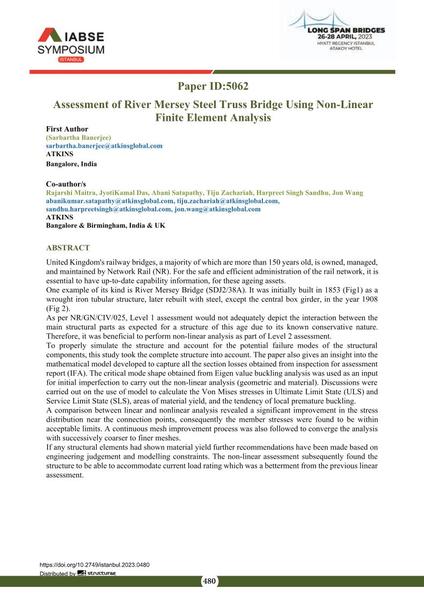Assessment of River Mersey Steel Truss Bridge Using Non-Linear Finite Element Analysis

|
|
|||||||||||
Bibliographic Details
| Author(s): |
Sarbartha Banerjee
(ATKINS, Bangalore, India)
Rajarshi Maitra (ATKINS) JyotiKamal Das (ATKINS) Abani Satapathy (ATKINS) Tiju Zachariah (ATKINS) Harpreet Singh Sandhu (ATKINS) Jon Wang Abanikumar (ATKINS) |
||||
|---|---|---|---|---|---|
| Medium: | conference paper | ||||
| Language(s): | English | ||||
| Conference: | IABSE Symposium: Long Span Bridges, Istanbul, Turkey, 26-28 April 2023 | ||||
| Published in: | IABSE Symposium Istanbul 2023 | ||||
|
|||||
| Page(s): | 480-500 | ||||
| Total no. of pages: | 21 | ||||
| Year: | 2023 | ||||
| DOI: | 10.2749/istanbul.2023.0480 | ||||
| Abstract: |
United Kingdom's railway bridges, a majority of which are more than 150 years old, is owned, managed, and maintained by Network Rail (NR). For the safe and efficient administration of the rail network, it is essential to have up-to-date capability information, for these ageing assets. One example of its kind is River Mersey Bridge (SDJ2/38A). It was initially built in 1853 (Fig1) as a wrought iron tubular structure, later rebuilt with steel, except the central box girder, in the year 1908. As per NR/GN/CIV/025, Level 1 assessment would not adequately depict the interaction between the main structural parts as expected for a structure of this age due to its known conservative nature. Therefore, it was beneficial to perform non-linear analysis as part of Level 2 assessment. To properly simulate the structure and account for the potential failure modes of the structural components, this study took the complete structure into account. The paper also gives an insight into the mathematical model developed to capture all the section losses obtained from inspection for assessment report (IFA). The critical mode shape obtained from Eigen value buckling analysis was used as an input for initial imperfection to carry out the non-linear analysis (geometric and material). Discussions were carried out on the use of model to calculate the Von Mises stresses in Ultimate Limit State (ULS) and Service Limit State (SLS), areas of material yield, and the tendency of local premature buckling. A comparison between linear and nonlinear analysis revealed a significant improvement in the stress distribution near the connection points, consequently the member stresses were found to be within acceptable limits. A continuous mesh improvement process was also followed to converge the analysis with successively coarser to finer meshes. If any structural elements had shown material yield further recommendations have been made based on engineering judgement and modelling constraints. The non-linear assessment subsequently found the structure to be able to accommodate current load rating which was a betterment from the previous linear assessment. |
||||
| Keywords: |
finite element analysis FEA non-linear analysis geometric nonlinearity material nonlinearity Eigen value Analysis
|
||||
